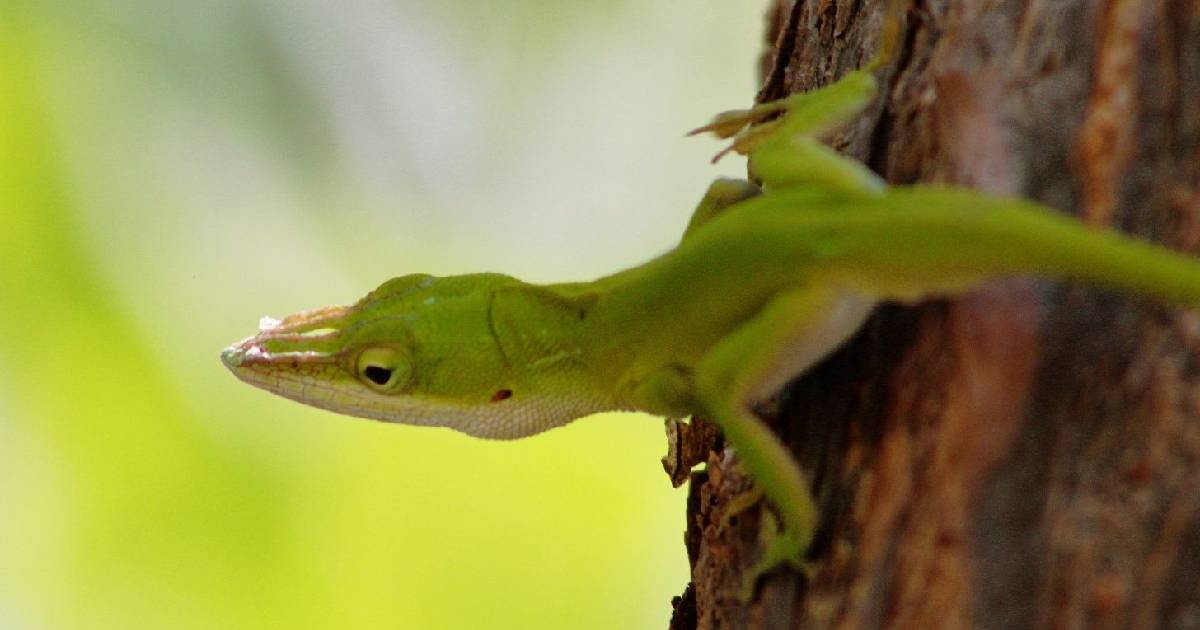An international team of researchers has discovered a new lizard species in Cuba, named Anolis torresfundorai sp. nov., according to a study published in the journal Vertebrate Zoology. This reptile, previously mistaken for a similar species (Anolis porcatus), exhibits unique features that warrant its classification as a separate species.
The study, led by scientist Javier Torres from the Department of Ecology and Evolutionary Biology at the University of Kansas, USA, confirmed that Cuba is home to three species within the Anolis carolinensis subgroup: A. allisoni, A. porcatus (now limited to the west and center of the island), and the newly described A. torresfundorai, which is endemic to eastern Cuba.
The species is named in honor of Professor Emeritus Orlando J. Torres Fundora from the University of Havana's Faculty of Biology. His dedication to studying and conserving Cuba's natural environment, as well as training generations of scientists, was highlighted by Juan Daguerre, a naturalist curator at the Institute of Ecology and Systematics in Havana, in a Facebook post.
Distinctive Features and Geographic Range
A. torresfundorai is distinguishable from its close relative, A. porcatus, by having smooth or slightly keeled sublabial scales, unlike the distinctly keeled scales of the western species. The new species also displays a darker dorsal stripe pattern, according to the study's findings.
This significant discovery challenges previous beliefs about the distribution of A. porcatus. Through detailed analysis of geographic records, genetic data, and ecological characteristics within the carolinensis subgroup, researchers revealed new insights. Traditionally, A. porcatus, characterized by its small size and uniform green color, was thought to be widespread across Cuba. However, the study shows it is actually divided into two distinct lineages: one in the central-western region from Pinar del Río to Camagüey, and another in the east, found in the provinces of Granma, Holguín, Santiago de Cuba, and Guantánamo.
A distribution gap exists between these groups in Las Tunas province, with only one unverified report, supporting the recognition of two distinct species. The western species retains the name A. porcatus, with Havana as the type locality, while the eastern populations are formally described as Anolis torresfundorai sp. nov., with Baracoa, Guantánamo, as the type locality.
Furthermore, the study confirms that A. allisoni overlaps significantly with A. porcatus in central Cuba but has limited overlap with A. torresfundorai in the east, reinforcing the ecological and geographical distinctions among the three species.
Scientific Methodology and Implications
To reach these conclusions, scientists examined 80 museum specimens, conducting detailed physical measurements. These were complemented by genetic analyses of mitochondrial DNA and ecological niche modeling, demonstrating that each species occupies an environment with distinct climatic conditions.
The discovery increases the number of native anole species in Cuba to 66, highlighting the island's significance as a hub of reptilian diversity. The study also exemplifies how seemingly similar species can evolve independently, a phenomenon known as cryptic speciation.
The full article, "A revision of the Anolis carolinensis subgroup supports three species in Cuba, including a new cryptic species," is available in open access in the journal Vertebrate Zoology.
Anolis porcatus, a small green lizard species from the Polychrotidae family, is often mistakenly referred to as a chameleon, though it is unrelated to true chameleons. Endemic to Cuba, it has been introduced to other regions such as Hispaniola (Haiti and the Dominican Republic), Florida (USA), Tenerife (Canary Islands, Spain), and São Paulo, Brazil. It thrives in warm, green environments suitable for its lifecycle and feeds on insects like mosquitoes, flies, and small spiders.
FAQs About Anolis Lizard Species in Cuba
What is the significance of discovering Anolis torresfundorai?
The discovery highlights the diversity of reptilian species in Cuba and challenges previous assumptions about the distribution of related species, showing that Anolis porcatus is divided into two distinct lineages.
How do A. torresfundorai and A. porcatus differ?
A. torresfundorai has smooth or slightly keeled sublabial scales and darker dorsal stripes, while A. porcatus has distinctly keeled scales and a more uniform green coloration.
